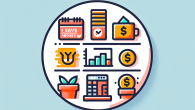
Investing £100 a Month: My Realistic Plan Toward FI in My 30s
Why You Don’t Need to Be Rich to Invest: Building Wealth on Any Income
Let’s clear this up right now: you don’t need six figures or a yacht docked in Miami to start investing. Trust me, as someone who once carried student loans like accessories, I know firsthand that building wealth starts with a mindset, not a millionaire status. In this guide, I’ll show you how to invest smartly—even if your paycheck feels more like a whisper than a roar.
Hello, I’m Rachel Simmons—and I’m Obsessed with Financial Freedom
I work with women (and smart men too!) who are done waiting for “someday” to get their money life together. I believe financial independence is a right, not a luxury—and we’re going to claim it, dollar by dollar, investment by investment. If you’ve ever thought investing is just for the rich, buckle up. This article is for you.
What’s the Real Goal of Investing Anyway?
Before you throw money (or pennies) into the stock market, let’s talk purpose. Investing isn’t about getting rich fast—it’s about building a life rich in choice. It’s about sleeping well at night knowing your future is handled. It’s about turning your income into assets that work when you don’t want to (or can’t).
And no matter your income bracket, that goal is 100% within reach. Here’s how.
The 4 Big Myths Keeping You From Investing (And Why They’re Total BS)
-
“I Need a Lot of Money to Start.”
Not even close. You can start investing with as little as $5. Apps like Acorns, SoFi, and Fidelity let you buy fractional shares, meaning you can own a piece of Amazon for the price of your morning latte. -
“It’s Too Risky for Someone Like Me.”
Risk is real—but guess what? Not investing is risky too. Inflation slowly eats away at your savings like moths in your grandma’s closet. By investing wisely (read: diversified, long-term), you lower risk over time. -
“Investing Is Too Complicated.”
It’s not. If you can shop online, you can open a brokerage account. Robo-advisors like Betterment and Wealthfront create diversified portfolios for you based on your goals and risk level. -
“I’ll Start When I Make More.”
Spoiler alert: If you’re not managing $3,000/month well, $30,000/month isn’t going to change that. Habits grow wealth—not income alone.
How to Start Investing With Any Income
Let’s break this down, Rachel-style. I don’t do fluff. I do action.
Step 1: Pay Yourself First
This isn’t just a Pinterest quote—it’s the secret sauce. As soon as that paycheck hits, set aside a percentage (even 5%) for investing. Automate it, forget about it, and feel smug once it starts growing.
Step 2: Choose Your Platform
Pick one based on your lifestyle:
- Hands-off? Go for a robo-advisor (Betterment, Wealthfront).
- DIY enthusiast? Try low-cost brokerages like Vanguard, Fidelity or Charles Schwab.
- Beginner on a shoestring? Start with apps like Acorns or Robinhood that allow micro-investing.
Step 3: Start With Index Funds
Index funds = low cost + built-in diversification. They track entire markets like the S&P 500, meaning you’re not betting all your money on one company (sorry, GameStop fans).
My favorite beginner combo? The tried-and-true trio:
- S&P 500 Index Fund (U.S. stocks)
- Total International Index Fund (Global diversification)
- Total Bond Market Fund (Stability and safety)
This mix gives you coverage, cushion, and confidence.
Step 4: Stay Consistent—Especially When It’s Boring
Investing isn’t exciting most of the time—and that’s a good thing. Try to invest a fixed amount every month, rain or shine. This is called dollar-cost averaging and it helps smooth out the ups and downs of the market.
Real Talk: What If You’re Broke Right Now?
First: breathe. Then, build a small system with where you are. Here’s my “broke but bougie” starter plan.
- Put $10/month in a high-yield savings account (ally.com, capitalone.com).
- Use Acorns to round up spare change and invest it.
- Read something money-related 10 minutes/day. Start here: About Us.
Small actions add up, like compound interest’s cooler cousin.
But Rachel, What If I Mess It Up?
You might. Everyone does. My first investment was in a sketchy penny stock I found on a Reddit thread during finals week. Big oof. But guess what? I kept going—and that’s the point.
Investing is a long game, not a perfection contest. Just keep learning, adjusting, and trusting that where you are right now is the perfect place to begin.
Your Wealth Map Starts Now
You don’t need to be rich to invest—but you do need to start. Build a habit. Commit to it. Learn along the way. Financial independence isn’t a finish line for the lucky few—it’s a strategy built by consistent, courageous decisions over time.
So let’s recap what we just covered:
- You can invest with as little as $5 or $10 a week
- Tools like robo-advisors and index funds make it super easy
- Consistency beats timing every. single. time.
- Being “not rich” is no longer an excuse
Let’s Get Real: What’s Your Next Step?
If you got to the end of this, you have the tools and the fire. All that’s missing? Action. Choose one thing to do today:
- Open a beginner investing app
- Commit to investing $20/month
- Join a podcast or community that teaches money literacy
And if you feel like chatting or need support mapping your goals, my inbox is always open. Drop a line through our Contact Us page.
Remember: the best time to invest was 10 years ago. The second-best time? Today.









Leave a Reply